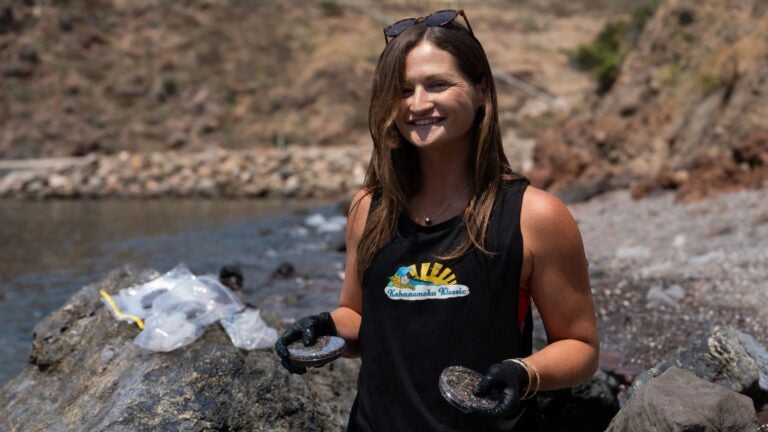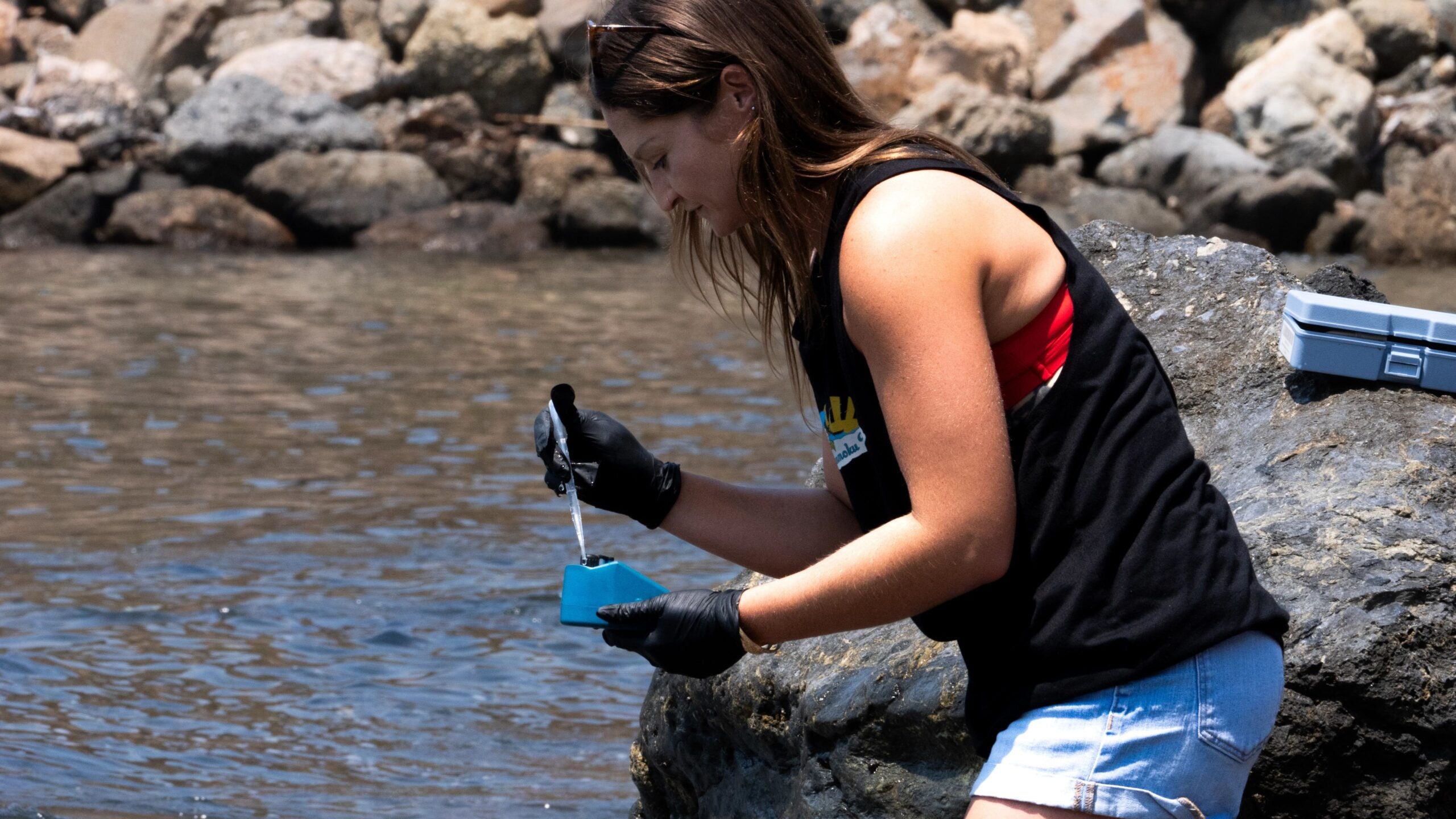
2024 Wrigley Institute Graduate Fellow Juliann Panehal, a PhD student in the USC Dornsife Department of Earth Sciences, gathers sediment samples to see what kind of oil degraders are hiding around Catalina Island. (Alex Luce, USC Wrigley Institute)
Don’t be Crude – Oil Spill Impacts on Marine Microbial Ecosystems in Southern California
You are probably familiar with the smell…. Maybe it was the last time you were pumping gas into your vehicle or maybe you were grilling on the BBQ and forgot to turn the gas tank off. In either case, we know what gasoline smells like—some people hate the smell, while others quite enjoy it! But I doubt many of us have thought about eating it. That’s because we aren’t microbes. And we are definitely not oil-eating microbes. Hi, my name is Juli Panehal, I am a PhD student in the Earth Sciences Department at USC, and I am here to introduce you to the world of oil degraders!
Oil-degraders are species of microbes that break down hydrocarbons (the molecules that make up crude oil) into CO2 and water and use the energy stored in these molecules as food. Although my project focuses on these degraders, I look at them through a slightly broader, and more impactful, lens: how their communities are impacted by oil spills. The immediate effects of an oil spill are obvious: pollution of surrounding waters, contamination of local seafood, harm to wildlife; but there are more subtle consequences as well. As mentioned, humans don’t have the capability to break down crude oil to use as a food source—and many other microbial species and animals alike don’t either. Therefore, when oil spills do occur, a phenomena similar to an algal bloom can take place: certain species (that degrade oil) flourish, while others are outcompeted, and a domino effect of environmental changes follows. Witnessing these changes is all part of the investigation laid out here.
The basis of this work all started with a tragic event that took place on October 1st, 2021, where a section of the San Pedro Bay Pipeline was hooked and dragged, resulting in a 13 inch split along its side. And although the incident was an accident, it had major consequences. The slash in the pipeline allowed for upwards of 144,000 gallons of crude oil (~ 3500 barrels!) to leak into the ocean. Occurring only 4.5 miles offshore, this spill allowed for copious amounts of oil to make its way to the coast: including protected marshlands in Huntington Beach… a location which my lab happened to have samples of from the year before!

Having had samples already collected at this site, our lab saw an opportunity and struck. My advisor, Roman Barco, contacted his collaborators at the marshlands and arranged to collect more samples following the spill. Our lab also reached out to USC Sea Grant, an organization under the NOAA (National Oceanic and Atmospheric Administration) that facilitates research to manage natural resources in an increasingly urban environment. And with their support, the story began. Our lab collected samples from the site multiple times in 2021 and once a year afterwards until now: creating a time series of the potential community response as a result of the spill. My role in this work is continuing this collection, using analytical techniques to investigate how the community changed, and potentially finding new species of degraders that have yet to be discovered!

But the scope of this project became even broader, and potentially more impactful, when I heard about the Wrigley Fellowship during my first year here at USC. When I found out the fellowship allowed for research to take place on Catalina Island, I thought “how cool would it be to look at the oil degraders there?!” For those not familiar, Catalina Island has multiple MPAs, “Marine Protected Areas:” regions designated towards conserving marine resources and ecosystems. I wondered if the minimal anthropogenic influence in these areas would appear in the makeup of the microbial community structure…and what would the introduction of oil—i.e. a potential spill—do to a place like that? I am now so thankful to have earned the fellowship and be able to answer these questions first-hand!
This summer, I am collecting water and sediment samples from multiple sites around Catalina, including an MPA, to see how these microbial communities vary. Later in my PhD, I will also be conducting lab-based experiments to see how the controlled introduction of oil could change these microcosms. I hope to use this information to understand the anthropogenic influence on these communities as well as a hope of finding new oil-degrading species that could be used in remediation efforts in the future.
Lastly, with this project, not only do I get to add to our knowledge of the microbial communities on Catalina, but I get to experience the island first-hand. I was able to volunteer for Wrigley Day, I took a van to collect samples and explore the island, and I met all of the wonderful staff who allow the institute to flourish on a daily basis (especially those who fed us all of the awesome food: thank you!!!). I am so grateful for the Wrigley and USC Sea Grant support that is not only allowing me to expand my project and the potential impact it has, but to carve out a place for me in the Wrigley community—a role I am excited to nourish and grow into my future career.
Juliann Panehal is supported by the USC Dornsife Wrigley Institute Graduate Fellowship.
